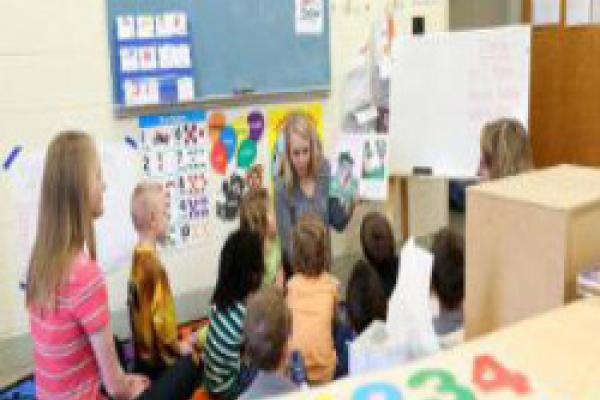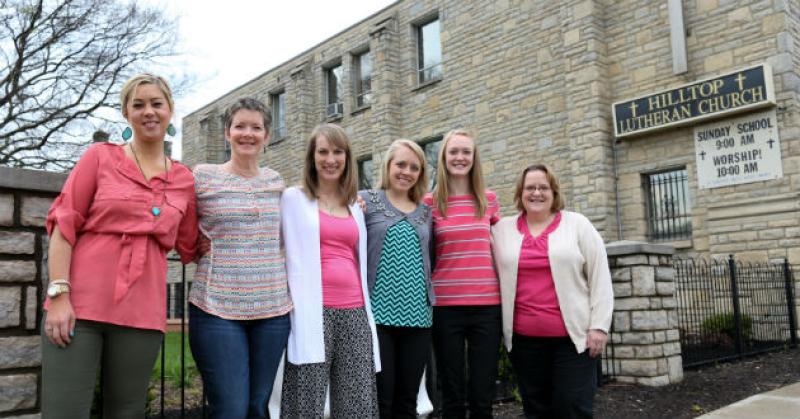Speech and Hearing Students Improve Pre-K Literacy Scores

Speech and Hearing Students Improve Pre-K Literacy Scores
Reading proficiency by the end of the third grade can be a make-or-break benchmark in a child’s educational development. Seventy-five percent of the students who are not reading at grade level in 3rd grade will remain poor readers in high school.
-- The Annie E. Casey Foundation
In the basement of the Hilltop Lutheran Church, you’ll find Hilltop Preschool, a non-profit organization offering free preschool to residents of the Hilltop area, on Columbus’ west side. Operated under the Early Start Columbus program with the City of Columbus, the school’s students and families struggle – all are under 200 percent of the federal poverty level, with the majority of families being under 125 percent.
Laura Moehrman, executive director of the Hilltop Preschool – now in its 7th year -- struggles to make ends meet, writes grants, herds students into classrooms, snags volunteers and sells candy out of her office to anyone passing by, to help pay for a graduation celebration at COSI.
In October 2014, 67 percent of Hilltop Preschool students were assessed falling “below average” on the National Center for Learning Disabilities’ GET READY TO READ! screening tool, a nation-wide research-based series of questions for children in the year before they enter kindergarten, to determine whether they have the early literacy skills they need to become readers. Only 33 percent of the students achieved scores of “average” or “above average.
Moehrman knew she had to do something. She also knew she had little to no money to hire a new teacher or specialist.
“I had the idea to submit a grant for a literacy program to the Ingram-White Castle Foundation (IWCF) because of their remarkable track record in supporting programs that help disadvantaged students achieve academic success,” said Moehrman. “I just didn’t have the second piece of puzzle figured out yet – who could provide the help.”
Fortunately, the preschool’s co-founder and board president, Jane Leach, and another board member Karen Carver, a speech pathologist, were familiar with the groundbreaking work in literacy intervention taking place at Ohio State’s Speech-Language Clinic. They encouraged Moehrman to give Ohio State a call.
“That phone call,” said Moehrman, “opened up a world of possibilities for our students, teachers and parents.”
Moehrman secured a $15,000 grant from IWCF, and together with Ellen Bonk, the licensed clinical supervisor at Ohio State’s Speech-Language-Hearing Clinic, set out to improve the preschoolers’ reading and comprehension levels and build a better support system for their parents and teachers.
“I was thrilled to get the opportunity to go out into the community,” said Bonk. We (Ohio State’s Speech-Language-Hearing Clinic) would be the first clinic to be on-site in a pre-K early literacy intervention program,” said Bonk.
Bonk selected two of her best graduate students from the clinic’s Speech Language Pathology MA Training Program — Breann Voytko and Katelyn Seitz — to develop weekly lesson plans and lead the classroom intervention sessions.

Over the course of 11 weeks, from March through May 2015, Bonk, Voytko and Seitz spent every Tuesday and Friday, two hours per day, at Hilltop Preschool working with students, their teachers and staff on targeted literacy-based skills in the classrooms.
Chicka Chicka Boom Boom
Armed with copies of Giggle, Giggle, Quack; Clifford Goes to Dog; and Chicka Chicka Boom Boom, Bonk and her students gathered their “Bumblebees” and “Grasshoppers” into reading groups and started with the fundamentals.
“Concepts of print were targeted at the beginning of the book reading session to reinforce and apply knowledge about titles, authors, illustrators and other aspects of the book,” explained Bonk. “After reading a book, narrative concepts reinforcing story script were discussed including characters, setting, problem and resolution. Our intervention sessions focused on two themes: phonological awareness (e.g., syllables, rhyming and first sounds) and ‘story sense’ concepts (e.g., character, setting, sequencing, major events, cause and effect).”
Having Bonk and her graduate students on site tripled student contact hours and increased the exposure to new skills for both Hilltop’s teachers and parents.
“Multiple exposure to consistent use of the same concept terms through a variety of activities is key in developing skills,” said Voytko. “Katelyn and I put together massive lesson plans with exercises around segmenting and blending of sounds (S sounds like snnnnake); syllables and words; rhyming (dog/fog); concepts of print; sequencing; narrative knowledge; comprehension; memory; problem-solution; character; setting and vocabulary.”
Literacy Scores on the Rise
At the conclusion of the 11-week intervention program, the preschoolers were tested to determine if their earlier literacy scores had changed.
The results?
“Eighty-nine percent (89%) of our students demonstrated higher literacy scores and 67 percent achieved “average” or “above average” on the GET READY TO READ! screening tool,” said Moehrman. “Those are simply remarkable statistics considering the many challenges we faced.”
Students were not the only ones who benefited from the Ohio State partnership.
“Our teachers benefitted from the modeling of techniques for speech, language and literacy concepts provided by Ellen and her students,” said Moehrman. “And our parents were empowered with information and skills to support their young developing readers, through take home sheets, scripts, special family events and parent/teacher conferences,” said Moehrman.
Moehrman believes that Intervention is necessary to ensure that at-risk children learn at a quicker pace, to help fill the gap that exists between them and their national peers.
“We must seek out emerging research and innovative partnerships like Ohio State’s Speech- Language-Hearing Clinic’s literacy intervention program if our children are to thrive and succeed.”
For Bonk and her students, they believe that as speech language pathologists, they have a responsibility to provide a best-practice instructional environment and do their best to ensure the success in kindergarten and beyond.
“It can no longer be a segregated effort that takes place in the classroom or outside the classroom by a specialist,” said Bonk. “We must work together . . . scholars, experts, speech pathologists and teachers, inside the classroom. . . that is cutting-edge practice”
For Ohio State students, working in the community is an invaluable lesson.
“Our whole field — speech and hearing science — is so rewarding,” said Voytko. “At the end of the day, you get to go home and know you’ve made a difference.”
Both Voytko and Seitz plan to use their education and in-the-school training to help others beyond graduation. Voytko is leaning toward pursuing technical expertise working with stroke survivors and Seitz will continue working with young school children.
